by Martin Laukkanen | Jul 26, 2018 | Flow, How to, Workflow
Flow is a great (one day) replacement for SharePoint Designer workflows, however at the moment the Project Online connectors are still in “preview” and as such as woefully inadequate. In my view the biggest omission is the inability to set custom fields, among many other failings this one is pretty much always step one or two on any workflow I have ever needed to create for Project Server.
You may have seen some MS demos where they show a quick easy way to circumvent this by using the HTTP action, unfortunately I’ve yet to find any online examples of that so I’m going to write one myself. This article focuses on Enterprise Resource custom fields but applies equally well to Task custom fields. However, the process is actually simpler for Project level custom fields and Paul Mather has blogged on the topic before here. Although he doesn’t cover Flow in that article, you can convert his JavaScript code to a JSON body and use it as as below. There’s also this StackExchange post that covers Project fields using a different method.
Updating Enterprise Resource fields via REST
It turns out this is not supported!
Please correct me if I’m wrong here, I’ve spent many hours looking for a solution for this from MS to no avail!
Well for me I figure if MS released an API 5 years ago and never got around to finishing it then supported or not I need a way to do my job. Fortunately it is possible via CSOM/JSOM to do this, and by understanding how all the client side API’s work you will see that it is possible and (arguably) fully supported to do this via REST using the internal methods used by CSOM/JSOM.
Updated Enterprise Resource default fields via REST
Before we look at custom fields lets cover how to set the default fields such as; Group, Email, etc. These can be set via the normal REST endpoint, and frankly this is how it also *should* be possible to set custom fields.
Assuming the resource exists and you want to update it by GUID, the following HTTP PATCH request will do it:
PATCH /sites/pwa/_api/ProjectServer/EnterpriseResources('[guid]') HTTP/1.1
Host: contoso.sharepoint.com
Accept: application/json; odata=verbose
Content-Type: application/json; odata=verbose
{
"__metadata": {
"type": "PS.EnterpriseResource"
},
"Group": "Test group",
"Email": "[email protected]"
}
That’s a raw HTTP request from PostMan, the important bits are the JSON and the PATCH type of request, yes a standard POST or PUT request will not work. In that JSON body of the request you can list multiple custom fields as long as you adhere to correct JSON syntax, for the full list of field names, browse to the endpoint in your browser: /sites/pwa/_api/ProjectServer/EnterpriseResources.
However if you look at the endpoints you’ll see the custom field values referenced by internal name, e.g.: Custom_x005f_000039b78bbe4ceb82c4fa8c0c400284
Unfortunately it is not possible to add to your JSON the CF value, like: “Custom_x005f_000039b78bbe4ceb82c4fa8c0c400284″: “Text value for field” as a result we have to work a bit harder.
Enter the ProcessQuery endpoint
(If you’re not interested in the why, but just the how to do this, you may want to skip to the next section!)
If you’re familiar with Fiddler traces of any of the SharePoint client side object models then you will have seen that all of the API calls made are translated into HTTP calls to an internal endpoint: _vti_bin/client.svc/ProcessQuery while not documented anywhere I have found, you can see that basically this is where the ClientContext.ExecuteQueryAsync(…) call from either CSOM or JSOM is performing the requested operation.
The ProcessQuery endpoint accepts a HTTP POST request with a body that looks something like this:
<Request xmlns="http://schemas.microsoft.com/sharepoint/clientquery/2009" SchemaVersion="15.0.0.0" LibraryVersion="16.0.0.0" ApplicationName="Javascript Library">
<Actions>
<Method Name="SetCustomFieldValue" Id="9" ObjectPathId="6">
<Parameters>
<Parameter Type="String">Custom_f825c154928ae81180da00155df8aa23</Parameter>
<Parameter Type="String">text field value</Parameter>
</Parameters>
</Method>
<Method Name="Update" Id="10" ObjectPathId="6" />
</Actions>
<ObjectPaths>
<Method Id="6" ParentId="4" Name="GetById">
<Parameters>
<Parameter Type="String">5e658680-838a-e811-80df-00155df8b01b</Parameter>
</Parameters>
</Method>
<Property Id="4" ParentId="0" Name="EnterpriseResources" />
<Constructor Id="0" TypeId="{3a609e5f-e2a1-497c-87a2-e5e8a781c096}" />
</ObjectPaths>
</Request>
That happens to be the query syntax to set a single text custom field for a resource. If you read through the content you can see (in order of Id properties) what is happening, in short the above translates to the following (pseudo) CSOM code:
var res = EnterpriseResources.GetById([guid]);
res.SetCustomFieldValue("Custom_f825...", "text field value");
EnterpriseResources.Update();
Pretty cool huh? :)
It get’s better, as if you trace in fiddler some code that does multiple things, like for example setting 3 or 4 custom field values, you will see that they are all batched into a single POST query just as you’d expect when using ExecuteQueryAsync in your code. The change in the method above is simply additional <Action> elements in the XML, one for each call to SetCustomFieldValue (note: incrementing the Id property is also necessary).
The remainder of that XML deserves a short explanation, ignoring the XML schema stuff the only other variable defined in the above example is a GUID: {3a609e5f-e2a1-497c-87a2-e5e8a781c096}. This GUID refers to the ServerTypeId that is defined in the Microsoft.ProjectServer.Client.dll file specifically the PS.ProjectServer constructor, and importantly “EnterpriseResources” is a public property of that class. So with that in mind you could re-use this GUID and make calls to any other public property to construct the call you need.
I prefer to cheat, and simply write a small snippet of JSOM (or CSOM) code that makes the call I want in REST, then use fiddler to get the XML body created when I make that call.
Calling a Project Online API from Flow
Now that we know what the HTTP request needs to look like we can start building a flow. Not so long ago this was much more difficult as we had to worry about OAuth2 and AzureAD apps and such, but now thankfully MS have added a new action to the SharePoint actions list which we are going to use:

I’ve created a new flow with a Project Online trigger “When a new resource is created”, and then added the above HTTP request action.
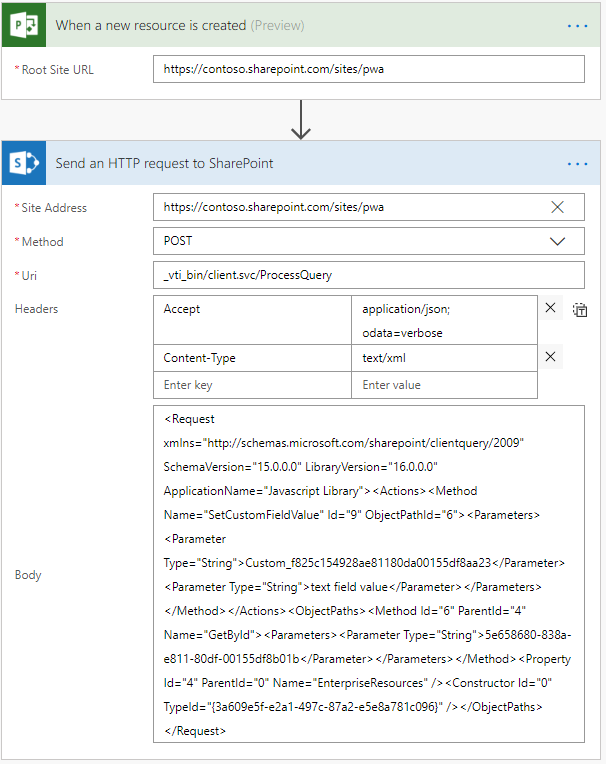
You need to populate the following values:
- Site Address: URL to your PWA
- Method: POST (for custom fields, or if out of the box fields PATCH)
- Uri: _vti_bin/client.svc/ProcessQuery
- Headers:
- Accept: application/json; odata=verbose
- Content-Type: text/xml
- Body: [Our XML body from the previous step]
Note: The header for Content-Type must be “text/xml” to match the content, if you were updating a default field using the JSON body from the beginning of this article, this would also be set to “application/json; odata=verbose”.
Thanks to the SharePoint HTTP action we don’t have to worry about authentication here, so actually that is it! Well almost.
Parameterizing the Flow action
Adding some variables to the flow allows us to parameterize the action based on whatever logic you want, once that’s done replace the values in the XML like this:

Important: Notice I have stripped the XML of tabs, spaces and line endings! This is required, if you don’t do that you will get an Unknown Error on larger query bodies.
Done.
What about default fields?
For completeness if you wanted to update the internal Group field for a resource, the http request action would look like this:
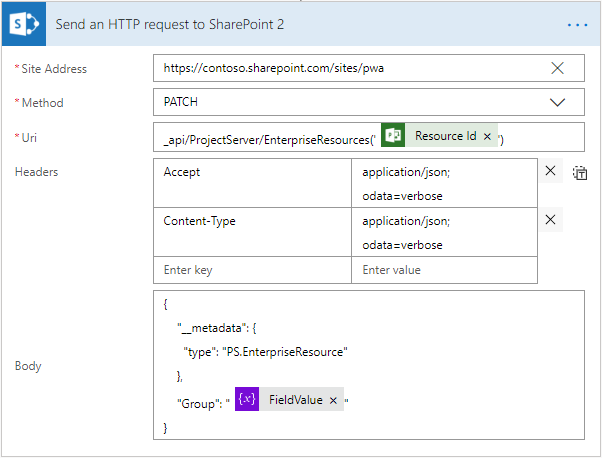
Note the resource GUID is in the URI and both the Method and Headers are different!
What about Lookup Table Values?
Lookup table value updates via REST have the same requirements as updating those values via JSOM (or CSOM), see my earlier post – Updating Lookup Table values using JSOM – for more on that.
In summary though, we need to first identify the lookup entry internal name, something like “Entry_412bb4bd5661e711a989000d3a28f1ff” then we need to pass that to the request as an array.
The request body now will look like this:
<Request xmlns="http://schemas.microsoft.com/sharepoint/clientquery/2009" SchemaVersion="15.0.0.0" LibraryVersion="16.0.0.0" ApplicationName="Javascript Library">
<Actions>
<Method Name="SetCustomFieldValue" Id="13" ObjectPathId="8">
<Parameters>
<Parameter Type="String">Custom_f825c154928ae81180da00155df8aa23</Parameter>
<Parameter Type="String">text field value</Parameter>
</Parameters>
</Method>
<Method Name="SetCustomFieldValue" Id="14" ObjectPathId="8">
<Parameters>
<Parameter Type="String">Custom_000039b78bbe4ceb82c4fa8c0c400284</Parameter>
<Parameter Type="Array">
<Object Type="String">Entry_412bb4bd5661e711a989000d3a28f1ff</Object>
</Parameter>
</Parameters>
</Method>
<Method Name="Update" Id="15" ObjectPathId="6" />
</Actions>
<ObjectPaths>
<Property Id="6" ParentId="0" Name="EnterpriseResources" />
<Method Id="8" ParentId="6" Name="GetById">
<Parameters>
<Parameter Type="String">0bd67eed-538e-e811-aadb-000d3a28f1ff</Parameter>
</Parameters>
</Method>
<Constructor Id="0" TypeId="{3a609e5f-e2a1-497c-87a2-e5e8a781c096}" />
</ObjectPaths>
</Request>
I’ve left in the previous example to demonstrate how to set two custom fields at once, but the important part here is lines 9 – 16 which include the additional syntax you will need to set an array type value. Once again passing the value as an array is required for both single value lookups as well as multi-value.
Final words
This ProcessQuery endpoint is not publicly documented by Microsoft but a long time ago I discussed this with some people from the product group and their response was that while not officially supported, it is supported in the sense that it will not change until JSOM and CSOM are both disabled, as that’s how they internally work.
So use it with the usual warnings, but biggest of all: I take no responsibility or offer no support for how you use the above. Feel free to ask a question in the comments below, if I can help I will, but no guarantees.
by Martin Laukkanen | Oct 29, 2015 | How to, Workflow
A lot has changed in Project Server workflows in the past few years, with the release of SharePoint 2013 and Office 365 the world of workflow completely changed. Fortunately SharePoint Designer’s (SPD) evolution into an actual usable tool for creating Project Server workflows filled the huge gap that previously existed for Project Server consultants and implementers, however at the same time the changes created a new major gap by completely blocking any sort of custom code in any workflows!
All is not lost though, with the changes in workflow we also received a handy set of new RESTful API’s to use so in theory at least we should be able to do a fair bit that previously required C# code via pure non-code-based SharePoint Designer workflows.
Putting the theory to the test
I have a theory with working with customers, that whatever is possible through the out-of-the-box features of a Microsoft product will never be enough after the first workshop. It seems that I like saying yes to customers. ;)
Scenario
My customer’s business process dictates that based on the result of an approval gateway the Microsoft Project schedule will require changes, specifically additional tasks need to be added to the schedule based on custom fields (or even a SharePoint list).
As there are no SharePoint Designer workflow actions that update project tasks, this would fall into the category of workflow built with Visual Studio (based on the MSDN: Decision tree: SharePoint Designer vs. Visual Studio), however the reality is that when you get down to it Visual Studio workflows share fundamentally the same limitation as those built in SPD i.e. declarative, no code workflows only (See the bottom of this article about some more practical limitations).
Solution
Let’s use my new favourite workflow action – the Call HTTP Web Service activity – in conjunction with the RESTful CSOM API for Project Server to actually create some tasks directly from SPD as follows;
- Get our task data – We’ll need task name, duration, start date, etc.
- Prepare our REST request – a bit of HTTP request header / body knowledge will be required but can be borrowed from some other examples like this one: Create a project site based on a custom field value.
- Post the http request and handle the result.
I’m going to skip a lot of details for this article and just focus on the above interesting bits, of course in the real world you’ll have to worry about publishing and checking out the project and although I don’t include those I will discuss check-out at least below as it is important. Additionally I will just create a single static task in this example, ideally you would get the values from custom fields, or better yet get a list of tasks to create using a separate OData http request then loop through creating each one.
PWA Workflow Configuration
Let’s keep this simple, you can use your imagination as to how this would fit into your requirement but I will even omit the approval and any other normal phases and stages.
Phases (Using Defaults):
1. Create
2. Manage
Stages:
1.1 Project Details – where we will get basic project details.
1.2 Create Tasks – where we will create the task(s) in the workflow.
2.1 Manage – we’re done, as you were..

Begin the SharePoint Designer Workflow
Here’s one I prepared earlier:
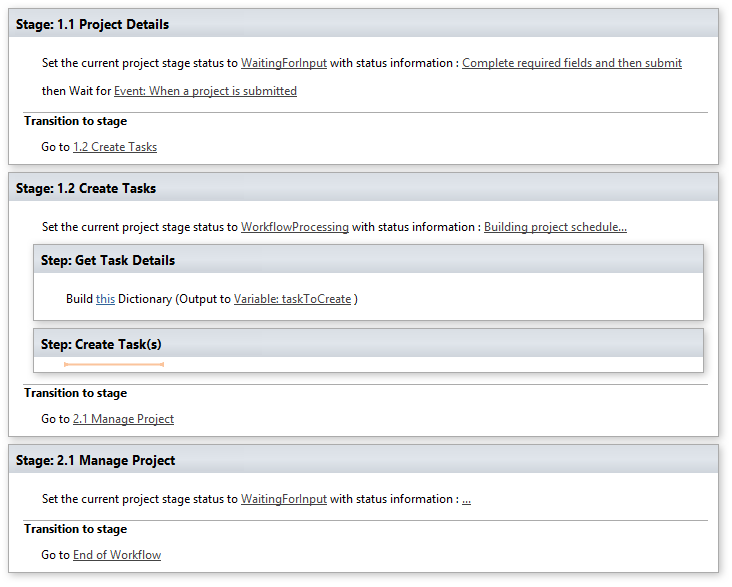
Okay so I’m assuming that this is not your first ever workflow, so the above is the following: Stage transition including basic history / status messages, plus in [stage 1.2] we are manually (and statically!) creating a dictionary of properties for the task we are going to add. (This is static and as per my comment above you probably want to dynamically populate this dictionary even by just setting the value(s) to the value of specific custom fields.)
Note on Check-in / Check-out
The project will need to be checked out to update the schedule, fact. However SPD workflow runs in the context of the user who started it, i.e. the PM in most cases. So in this example I’m going to assume that the project is currently checked-out by the PM and just go ahead and do the update. You may be surprised but this will actually work, of course in reality you will have to check for this and if an error occurs then retry after checking-out – or conversely you could require the project be checked in before submitting and then do the check-out / check-in every time.
Preparing the new task dictionary
SPD uses extensively the Dictionary object in the HTTP Activity, both for the headers, body and return values, so to create our task we are going to need a dictionary formatted in the format expected by the Project Server REST API for creating new tasks. This is where it starts getting interesting.
It turns out that this is easier that you might have guessed, see those properties of the task; Name, Duration, ParentId, etc? Guess what dictionary values we’ll need? :)
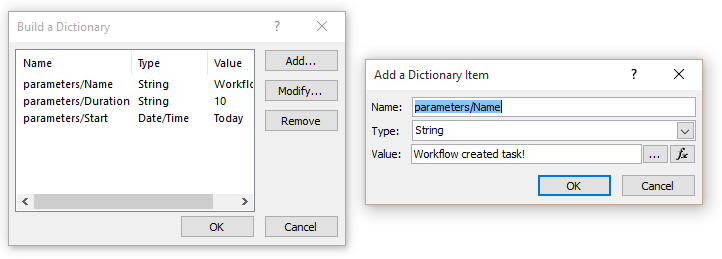
On the left is the complete dictionary, and on the right is the properties of the first “Name” row expanded. Surely it’s not that simple? For once yes it is.
So create the dictionary from the menu Action – Build Dictionary, populate the dictionary with the fields you want, specifically you’ll need Task Name as a minimum, and importantly pay attention to the data-type, for this the MSDN link above is handy, names are strings, dates are dates, parent task Id is a GUID, etc. (Note: Duration is text! Hello manual tasks!)
Prepare the HTTP request
Now we’ll need another dictionary for the request header, if you’ve previously read the MSDN article on using the Bulk update of custom field values, or my article on creating a Project Site based on a custom field, then you’ll see here we need the same thing.
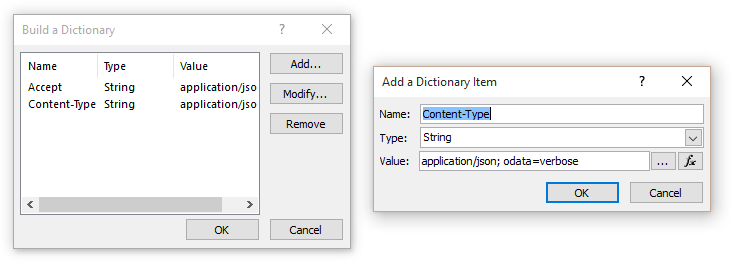
Two string entries needed:
Accept: application/json; odata=verbose
Content-Type: application/json; odata=verbose
The great thing about SPD workflows is that it takes care of the authentication and any other headers, so that is everything that we need.
Submitting the HTTP request
Now we get to use my favourite activity: Call HTTP Web Servie.
Insert the activity, first click the this URL and we’ll build the request URL by basically calling the following REST resource endpoint: MSDN: PS.DraftTaskCollection.add Method, note from MSDN the syntax is as follows:
POST http://<sitecollection>/<site>/_api/ProjectServer/Projects('projectid')/Draft/Tasks/add(parameters)
So we need to dynamically create the URL as follows;
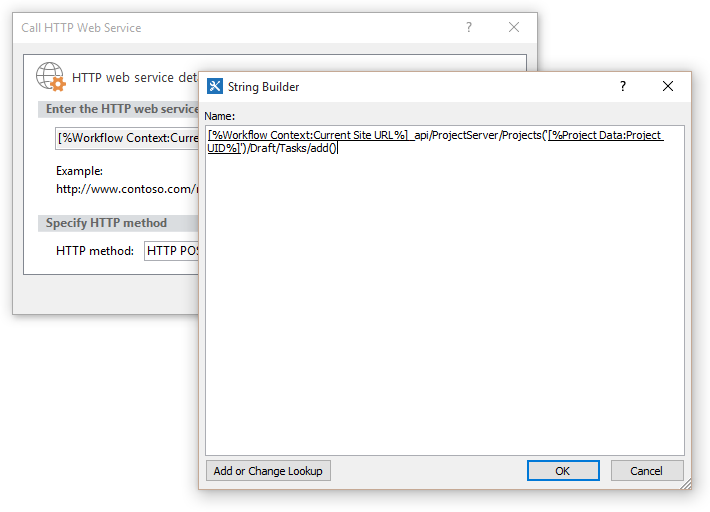
- Use lookup params to insert the Workflow context: Current Site URL
- Append the text “_api/ProjectServer/Projects(”)/Draft/Tasks/add()“
- Then insert the Project Data:Project UID into the text.
- Finally (importantly) Select HTTP POST as the HTTP method.
Next right click the activity and open properties to assign the request header and body, and while there specify something for at least the response content (so we can check the return http code).
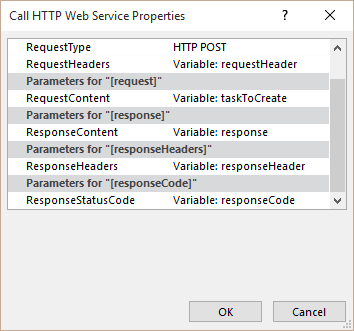
Check the Response
Okay we’ve made our REST call, now we just log the response to the status field, and to help with troubleshooting in the case where “responseCode” is not equal to “OK”, I actually log the full response to the history list.
(Warning! Logging to the history list like this has a max length of 255 characters, so if the error message exceeds that you will get another error and the workflow will fail! Use the Extract Substring activity to avoid this.)
You should now have something looking like this:
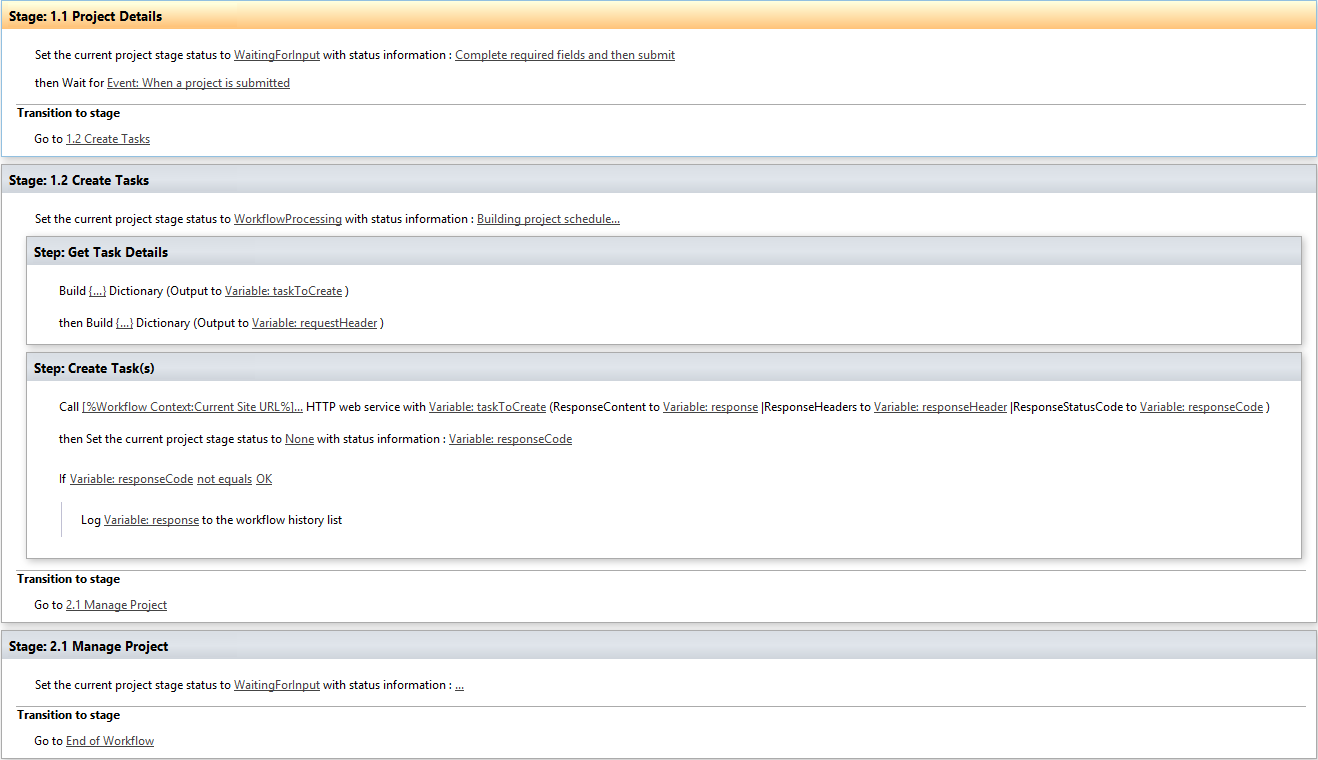
Finally save and publish the workflow and you’re ready to go.
Time to test
Associate the workflow to an EPT, then create a project. As we’re not doing anything special in the first stage submit and you should see the workflow status info as “Building project schedule…” (looking good so far!).
Give it a minute and then refresh the page:

Better yet, open the Schedule PDP and you will see our new task:

Neat.
Further Thoughts, Experiences and Limitations
This method opens up quite a few options when it comes to SharePoint Designer workflows, the ability to interact with all levels of the Project Server API via a workflow opens the possibility of working with any aspect of project data (tasks, assignments, resources, etc?).
However my experience of pushing this to the limit does raise some significant limitations:
- SPD Workflows can contain a maximum of 50 local variables.
This sounds like a lot but it doesn’t take long before you’re needing to re-use variables, especially if you’re like me and you like nice verbose and unmistakable variable names. (Fifty max is killing me! ;))
- Dictionaries are great but you can’t dynamically update them.
This is where we see the true limitations of SPD vs Visual Studio, doing a simple loop in code then adding the results to the end of a collection (array / dictionary etc) is pretty basic stuff, but with SPD can’t be done. You can loop yes sure, but you can only build a dictionary either statically (like I did above), or from the results of a query such as a http OData request.
- Finally as a developer I’m going to call out this as a major limitation; single concern / no source control. (Ahhh!)
While creating some large workflows you don’t know how many times I have panic’ed thinking that an overly-long and unresponsive save or publish of my work has just crashed SPD and corrupted the whole workflow (it actually happened at least once), give me source control and a proper separation of concerns and let me sleep at night, please. :)
Recommended Reading
Here’s a great article on working with SPD dictionaries that I’d recommend: How to work with dictionaries in SharePoint 2013 and Office 365 workflow)
Complete basic operations using SharePoint 2013 REST endpoints
PS namespace MSDN reference (want to know what REST endpoints are available for Project Server?)
Download the solution
Create-Project-Tasks-Workflow.zip
Enjoy!
by Martin Laukkanen | May 29, 2015 | How to, Project 2016, Project Online, Workflow
One of the nice new features recently released on Project Online that will also be available for on-prem sometime in the future (PS 2016 or maybe if we’re lucky 2013 sp2?) is the ability to create custom fields via workflow using the new API CreateProjectSite. While on its own this may be a rather small change what it opens up is the possibility to completely control the Project Site creation which previously had only the out-of-the-box options i.e.; on or off!
So using this new feature I have created a walk-through here to resolve an often asked customer requirement:
How can we create the Project Site using a name other than the Project Name, e.g. a Project Number?
Solution Overview
Note: This solution can be used today on Project Online, but as of yet will not work on Project Server 2013 on-premises.
In order to fulfill this requirement we will need to create a simple two stage workflow and associated Enterprise Project Type to be the default project type.
Stage 1: Project Registration
Used to collect project details including “Project Number” which will be a required field. Other PDP’s such as the project schedule will not be available.
In this stage no project site is available.
Stage 2: Project Execution
First thing upon entering this stage the project site is created using the details from the previous stage (site URL = “Project Number”), then other PDP’s, etc are shown to allow for the project to continue.
Project Online Configuration
I will go through the configuration of PWA for the workflow in brief, if you are not familiar with creating workflows or need further information then I’d recommend the following MSDN How to: How to: Create a Project Server workflow for Demand Management.
Firstly you will need a custom field called “Project Number” that is configured as a Project entity, type Text and Workflow-controlled enabled, as so:

Next create / edit the “New Project” PDP, and add the Project Number field to the PDP.
Optionally leave the field out of the PDP and go and install the Nearbaseline ID App which will set the project number in the background once the project is created (ahem shameless plug).
Now create the required Stages and Phases as follows:

Note that in the Project Registration stage the “Project Number” field must be marked required.
Now create an Enterprise Project Type using the New Project Page created above and for now leaving everything else default / blank as you’ll have to come back and associate the EPT with your workflow after the next steps.
Finally configure the default settings to NOT create project sites automatically from PWA Settings > Connected SharePoint Sites > Settings, as follows:

With that all setup we’re ready to create our workflow in SharePoint Designer.
Workflow Creation in SharePoint Designer
The workflow creation is based on the steps documented in the MSDN guide: Project Online: Bulk update custom fields and create project sites from a workflow, as such I will skip some of the details and suggest you review that article if you have any problems.
Open SharePoint Designer, create a new SharePoint 2013 Workflow – Project Server workflow and add the following:
- Insert two stages Project Registration & Project Execution
- Optionally set the stage status in the Project Registration stage to WaitingForInput.
- Set the transition to go to the Project Execution stage.
No additional wait for submit event is really required here as the workflow will automatically wait for all required custom fields to be entered before allowing submit.
- Now in the Project Execution stage add a step in which you can add the Create Project Site call as documented in the MSDN article.
- Finally terminate the workflow as the final transition.
Your workflow should look something like this:

The only change from the steps outlined in the MSDN article is in the forth step where the URL is constructed for the CreateSite call, in our case we want that to reference our “Project Number” custom field in the parameter in CreateProjectSite(parameter), so your URL should look like:
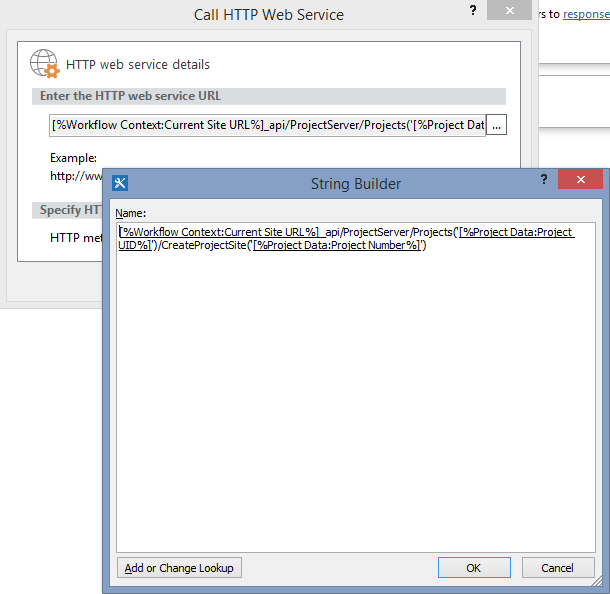
Note: Don’t try to cut and paste those URLs if you do so you will lose the special [%tags%], use the Add or Change Lookup button to insert the tags.
Once your workflow is done, save, publish and return to PWA and associate it with your EPT that you created then test!
Solution Download
Find attached below the SharePoint Designer Workflow solution created above exported as a Visio diagram, note that I cannot provide any guarantees or support for this downloaded Visio file.
Download: Demo Create Project Site from ECF
Screen shot of the workflow in Visio:

Hope this is useful to someone out there!
by Martin Laukkanen | Aug 4, 2010 | Workflow
I’ve just had my first opportunity to dive into the recently released by Microsoft Project 2010 Solution Starters (see Jan’s blog post), what first caught my eye was the Demand Management Dynamic Workflow solution which aims to allow you to: “Dynamically create a linear workflow based on stages”.
My first impression is WOW!
This is a very simple way to create basic workflows using a simple Infopath form in PWA, the amazing thing is it handles the approvals so well with options that should cover most requirements, here’s a screenshot:

Using the tool is dead easy, just the following simple steps are required to create a new workflow in no time at all:
- Once installed go to http://server_name/pwa_name/_layouts/WrkSetng.aspx on your server
- Click “Add a workflow”
- Create a new workflow based on the “DM DynamicWorkflow” template
- Configure each of your phases/stages using all your pre-created stages with your approval requirements, then submit to finish
- Now return to PWA and in Server Settings create or assign the newly created workflow to your Enterprise Project Type
There are some limitations of course, this really only does cover linear approval / rejection scenarios, if you need anything more complex like a return to previous stage on rejection from my testing it looks like you’ll still be needing your Visual Studio skills. But still I can see the majority of workflow requirements being met by this little gem!
Check out the CodePlex home here for downloads and installation details: http://code.msdn.microsoft.com/P2010SolutionStarter/Release/ProjectReleases.aspx?ReleaseId=4631
by Martin Laukkanen | Apr 11, 2010 | Development, Project 2010, Troubleshooting, Workflow
I’ve been working on a full end-to-end demand management workflow over the past couple of weeks and unfortunately as RTM is due any day now, much of the final documentation is still not public, meaning that some things just need to be figured out.
One problem that I found is the custom workflow task form, which has a very useful "Review project details" link on it. However if you have used Microsoft’s demo2010a image, then you’d see that for all of the workflow’s the link initially does not work. (See image)
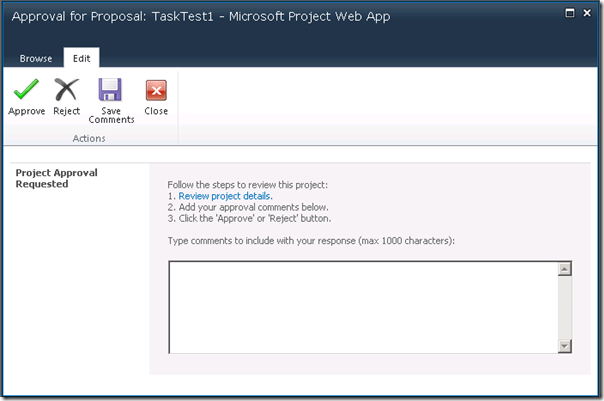
Fortunately this one was relatively easy to guess, thanks MS for making it quite obvious!
Firstly a custom workflow task content type called PSWApprovalTask is created by default in the PWA site "Project Server Workflow Tasks" list, here’s what it looks like out-of-the-box:

Interestingly though, it is not by default added to the list content types, BUT if you run through the Sample Proposal Workflow once then you will see it appear in the list automatically. For the purpose of this just use the ‘Add from existing site content types’ option in List Settings to add it:

Now another interesting thing is apparent on the list settings page:

Specifically Microsoft has pre-defined three Columns named: Project Name, Project Owner and ProjectUid (and some others..), however they are not added to the content type by default either, but they are used in the views including the default My Tasks.
To the point:
Now getting to the point of this post, if you use the content type and populate all of those fields then the task approval page will work as expected! Specifically the ProjectUID Column needs to be populated with guess what: the Project’s GUID, once that is done then the link works as expected!
Too easy!
Well unfortunately not. The Visual Studio Workflow Activities included with Project Server 2010 gives you the very handy ReadProjectProperty action, however while having a choice of either reading a Custom Field based on GUID or a pre-defined built in field based on name, it does not include Project GUID. This is where it gets complicated.
The “simple” solution is to use PSI, then using something like this nice little method created by Chris Boyd you can retrieve the GUID by providing the Project Name using PSI method ReadProjectStatus.
Unfortunately having to use PSI in what otherwise could be a very simple SharePoint workflow in my opinion is clunky, it would be very nice if MS could add the Proj_UID property to the ReadProjectProperty action!
If you’re interested, based on Chris’s blog post linked above, here is an extract of my code to get all of those fields working (Note that this plugs in nicely to my last code post: Extending the Branching Workflow):
// Declare your PSI Stuff
private static WebSvcProject.Project project = new WebSvcProject.Project();
private void createTask_InitApproval(object sender, EventArgs e)
{
[… insert your other required task attributes …]
taskProps.ExtendedProperties["Project Name"] = Proj_Name[0];
taskProps.ExtendedProperties["Project Owner"] = Proj_Owner_Name[0];
taskProps.ExtendedProperties["ProjectUid"] = GetProjectUidFromProjectName(Proj_Name[0]);
}
public static Guid GetProjectUidFromProjectName(string projectName)
{
Guid projectGUID;
project.Credentials = CredentialCache.DefaultCredentials;
WebSvcProject.ProjectDataSet readProjDs = new WebSvcProject.ProjectDataSet();
readProjDs = project.ReadProjectStatus(
Guid.Empty,
WebSvcProject.DataStoreEnum.WorkingStore,
projectName,
0
);
if (readProjDs.Project.Rows.Count == 1)
{
projectGUID = new Guid(readProjDs.Project[0].PROJ_UID.ToString());
}
else
{
throw new Exception("No Project by the name: " + projectName + " Found");
}
return projectGUID;
}
Enjoy!
Update 4/08/2010:Check the comments below for a much easier way to correct this issue, without the use of PSI.
by Martin Laukkanen | Apr 11, 2010 | Development, How to, Project 2010, Workflow
With Project Server 2010 you get an out of the box workflow named ‘Sample Proposal Workflow’, this is quite a good demonstration as it includes all of the usual things you might see in such a process; Validation, Approval, Selection, etc. However unfortunately as of this time (days before RTM) the source for this sample is still not available, at the moment the only SDK example is a simple Branching Workflow which only includes a single validation step.
I had an opportunity at the Sydney Ignite to ask Jan Kalis about this one, and he assured me that the full source for the sample will be released sometime around RTM, but we’ll have to wait a little bit more for that one.
In the meantime the world moves on and I have been busily writing my first full blow demand management workflow for a customer deployment, and so I thought I would share some of what I have done here. To that end I have taken the SDK Branching Workflow and extended it to include an Approval stage similar to that in the Sample Proposal Workflow.
Read below for what I have done and what you need to test it for yourself, then download my Visual Studio 2010 project below.
Branching Workflow with Approval:
The steps below are a summary of the changes made to the Branching Workflow, for a more complete how-to guide I very strongly suggest that you read the SDK Branching Workflow article and if you complete the examples there you will end where my steps below begin. Furthermore all the general requirements for getting this running (Visual Studio 2010 etc) are in the SDK article.
Before you start (or download):
This example is built on a default PWA instance, I have renamed the out of the box Sample Proposal Workflow to ‘Branching Workflow with Approvals’ then after deploying the code changed the workflow selected to the new one. All other PDPs and Stages are used as is, and the only other change required is an optional one below in step 5 below (see image).
Changes Made:
- Starting with the SDK Branching Workflow (note that if you download it in the p14betasdk then the code is incomplete and a few steps from the MSDN article must be completed). I also renamed the Feature and the Workflow in the deployment package to avoid confusion.
- Then I added a pre-build event command to automatically regenerate the Strong Name. (Can be removed, but just makes testing easier)
- Added a step after the Proposal Details Stage where the workflow goes to Proposal Selection Stage in Select Phase (updateProjectStageStatus20 – Waiting for Approval) – Note I have used the Select phase as my ‘Approval’ phase, I am not doing anything with Portfolio Selection here just approval.
- Next I read the Project Properties of "Project Name" and "Owner" for the Workflow Task (These are optional and just for completeness).
- Read "Portfolio Managers" Project Server Group membership to create approval request for first person returned in group.
- Create Workflow Task using CreateTaskWithContentType and assign to approver and populate task properties with Project Name and Owner.
Important: In order for these task properties to work you must ad the built in Columns to the PSWApprovalTask content type by editing the Default Workflow Approvals, then updating the content type to include the existing list columns.
(See Screenshot from List Settings PSWApprovalTask Content Type Properties)

- Then we add a while activity onTaskChanged to wait for the Approval task to be actioned. In this step the ExtendedProperties are checked for a value "Approved" anything else results in Rejection.
- And finally an IfElseActivity is used to branch on the Approved / Rejected result.
- If true then continue to end and UpdateProjectStageStatus to Execution stage.
- Else UpdateProjectStageStatus to Not Selected state and Terminate.
Here is the result in Visual Studio:
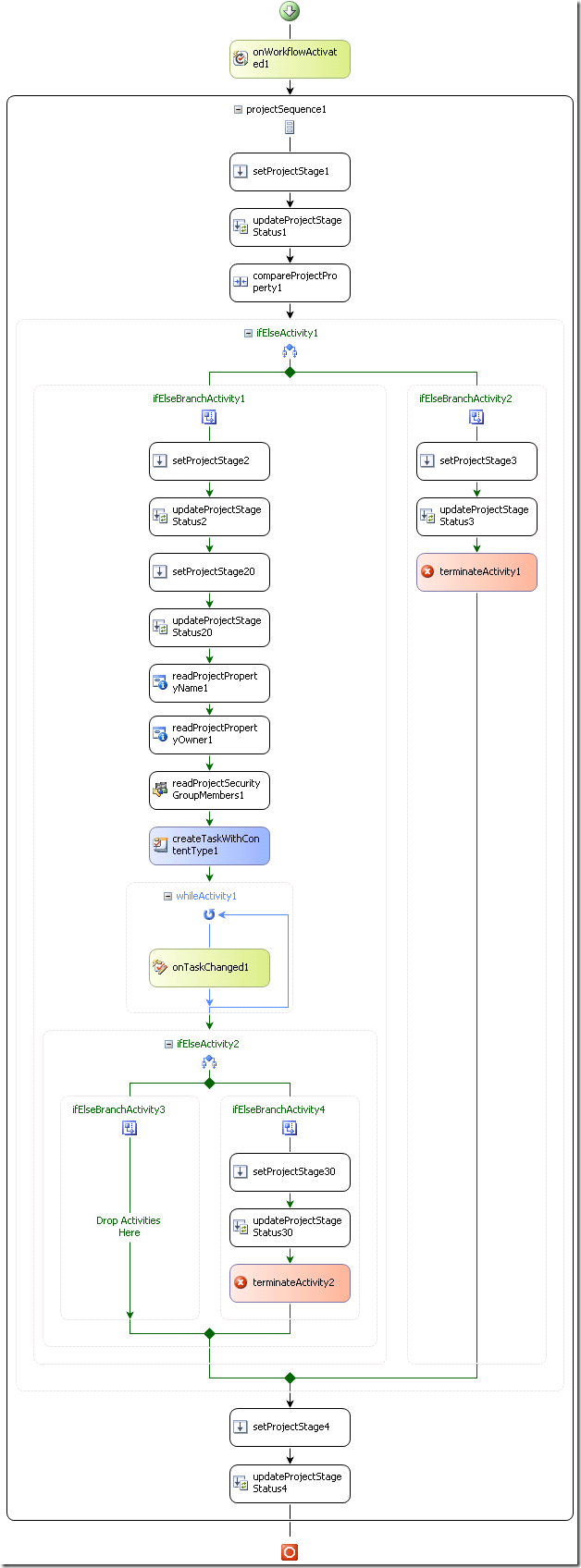
What’s left?
- Email notification? You can simply use the SharePoint list notifications on the Workflow Task list as a simple and consistent email notification method.
- Portfolio Selection? I’ll leave that one to you.
Technical Details:
This example was created on the following beta software, meaning that things might change by RTM:
- SharePoint Server 2010 RC Build
- Project Server 2010 RC Build
- Visual Studio 2010 RC Build
Download the full project files in a zip here. (*see update below)
MSDN References:
How to: Create a Branching Workflow <http://msdn.microsoft.com/en-us/library/ee767701(v=office.14).aspx>
Step 3: Create the Workflow <http://msdn.microsoft.com/en-us/library/ms580283.aspx>
UPDATE 3/09/2010:
I thought that I’d revisit this one as clearly from the comments there was something wrong after RTM, basically the problem everyone seems to be having relates to the ‘WorkflowTaskCTypeID’ defined. Somehow what I had in the BranchingWorkflow.cs file is actually incorrect, the solution has the following on line 46:
public String WorkflowTaskCTypeID = “0x0108010038A52C27344148C9B9214F82C7C0298500544602C73FFD1245BCC090442C85426B”;
When it should be:
public String WorkflowTaskCTypeID = “0x0108010038A52C27344148C9B9214F82C7C02985?;
Not quite sure where the first one came from (and why it worked?!) but that fixed it for me. If you update that line then recompile / rebuild you should be good.
PS. I don’t use the CreateTaskWithContentType anymore, have a look at the 2010 workflow activity (OfficeTask class) used in the Sample Proposal found in the SDK: http://msdn.microsoft.com/en-us/library/microsoft.office.workflow.actions.officetask.aspx
![]()

























